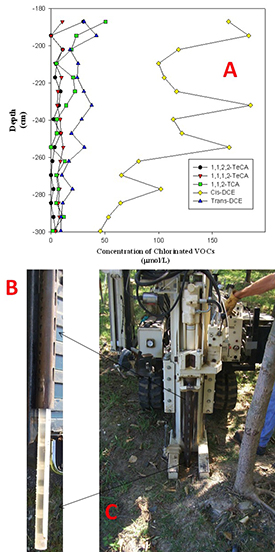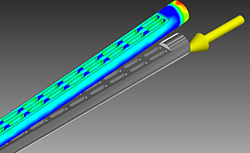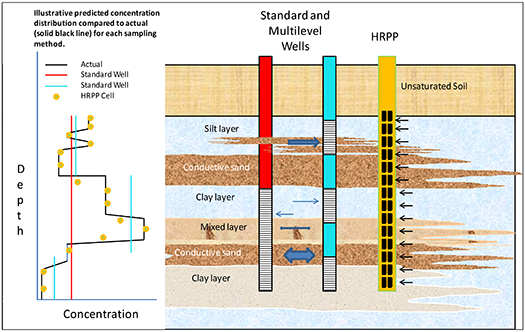Dr. William A. Jackson Awarded $1M DoD SERDP Grant to Develop and Demonstrate Contamination Profile Tool and Subsurface Model

By Amanda Miller
and Dr. William A. Jackson
The Department of Defense (DOD) has prioritized, for many years, solving pressing environmental issues resulting from historic use of chemicals at their sites. There are currently thousands of these sites located across the country. Most of the contamination issues derive from time periods prior to the common use of engineered disposal practices or environmental regulations. Chlorinated solvents, for example, were used heavily in a variety of capacities related to both maintenance and field activities. These organic compounds are normally immiscible (unable to dissolve well in water) and fairly dense, permitting them to sink into soils and thus affect the purity of groundwater.
There are numerous technologies and models available to both predict where and how fast the subsurface contamination will move and how it might affect groundwater in nearby areas of the military site, as well as technologies to facilitate soil and groundwater restoration. However, all of these technologies are dependent on understanding where the contamination is located, how much contamination is present, and what processes are affecting the contaminants. This information can be difficult to obtain, as the subsurface is often very complex, consisting of numerous types and variable depths of soils. Traditionally, this information has been primarily obtained by drilling wells and testing groundwater. However, data from wells often only produces information about the soil through which water moves most easily. These wells are also expensive to install and generally only give information over relatively large zones. What is needed is a method to produce high resolution data on not only the presence of contaminants, but also on how fast they are moving and what is happening to the contaminants as they move. With this information, regulators and engineers can make better decisions regarding which sites require clean up and how to best clean up those sites. This not only leads to a cleaner environment and reduced human health risk, but also saves millions of dollars in clean-up costs.

B) Photograph of the direct insertion of a proto-type sampler.
Click to enlarge
With support from the Department of Defense in the form of a $1,000,000 grant, Dr. William A. Jackson, professor and associate chair of civil, environmental, and construction engineering, is building a more sophisticated solution. Jackson's research is primarily focused on developing and demonstrating a High Resolution Passive Profiler (HRPP) as a fine-scale delineation tool for saturated sub-surfaces. The HRPP will be able to be directly inserted into groundwater at depths exceeding 30 feet. This sampler will directly measure groundwater and contaminant flux at the centimeter-scale, which will allow for more detailed and accurate models. This level of detail is far beyond what can be achieved by existing methods, and this new sampler will also simultaneously assess water velocity (the speed and direction the groundwater is moving, including its current and anticipated location), microbiological communities (bacteria, for example, that are possibly present and can be used to an advantage), and abiotic/biotic reactions (natural processes that are already occurring below the surface). This is important as the choice of clean-up method is very dependent on the aquifer conditions and what biological processes are or are not occurring, as many sites utilize bacteria to treat the contamination.

Click to enlarge
The HRPP created through Jackson's research has great potential to increase the accuracy of subsurface models. This will create a new methodology for simultaneous fine scale delineation of contaminant distribution and other key data. With better models, it will be easier to predict the location of contaminants, and other variables and to create a more customized plan to attack the problem at its source. The HRPP will contribute to determining realistic cleanup goals and duration, as well as appropriate remediation options. The new sampler technology should also save resources, time, and money on decontamination projects, allowing the Department of Defense to reallocate saved costs to its primary objective of protecting the country. And, finally, this research will lead to increased understanding of the role fine scale processes play in contaminant fate, helping to reverse and prevent groundwater contamination in the future.
Jackson will work with Dr. Stephen Morse, assistant professor of civil, environmental, and construction Engineering, researchers at the Chicago Bridge & Iron company, as well as two exceptional graduate students for the duration of this research. During the course of the three-year project, the first two years will be devoted to lab studies and construction of the HRPP, while the final year will be utilized for field trials. There is also potential for the Department of Defense to provide support for large-scale demonstrations. If proven successful, Jackson's technology would be implemented at DOD sites across the country in order to immediately impact the accuracy and efficiency of decontamination processes.

Click to enlarge
Grant Title:
High Resolution Delineation of Contaminant Concentrations, Biogeochemical Processes, and Microbial Communities in Saturated Subsurface Environments
Edward E. Whitacre Jr. College of Engineering
-
Address
100 Engineering Center Box 43103 Lubbock, Texas 79409-3103 -
Phone
806.742.3451 -
Email
webmaster.coe@ttu.edu
